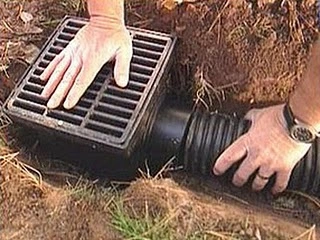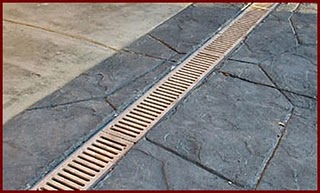French Drain Installation— French Drains are designed to do a lot of things. If you have an area that has unwanted water standing in it or running across it. A French Drain can be the answer.
A French Drain is a trench that runs across the Drainage Problem Area. A French Drain Pipe is placed in the bottom of the trench. The French Drain Pipe is perforated with thousands of small holes. In most cases the Drain Pipe has a nylon soc around the pipe to act as a filter for the French Drain. The French Drain trench is then filled with some type of small rock or stone. We typically use crushed 1 inch Lime Stone to cover the French Drain Pipe. The dirt that was dug out of the trench is taken away or spread out around the French Drain. The Lime Stone replaces the dirt and fills the French Drain Trench all the way to the surface.
Oklahoma Drainage has been installing French Drains since 1993. We also install Fescue Sod and Bermuda Sod by the pallet as well. A pallet of sod will cover about 450 square feet.
Oklahoma Drainage also installs Surface Drains of all kinds including Channel Drains in Driveways or 12 inch, 9 inch, and 6 inch Drain basins in yards and sidewalks and along driveways.

Oklahoma City Channel Drain
Sorry I got sidetracked. Back to talking about French Drains. French Drains keep water off of Foundations, Sidewalks, and Driveways.
THREE BAD THINGS CAN HAPPEN WHEN WATER SITS AGAINST CONCRETE.
- Concrete can break down and deteriorate from temperature change when the water freezes and thaws. Lots of cracks can occur.
- Concrete can be de-stabilized. Supporting soil can be washed away or removed.
- Mold!!! Yikes!! Mold needs water. Water against a foundation or saturating it is definitely a risk for mold to occur. Mold development can be a very small issue or it can be a Huge Problem. If Black Sludge starts to appear on top of ground near a foundation, action should be taken. I have seen extreme mold situations where a home had to be condemned. Again, this is very rare, but it does happen to good people.

Digging trench for French Drain
In the pictures below, water was running across the walkway and into the pool every time it rained hard. We pulled up the necessary stones on the side that the water was coming from and put a French Drain underneath. A trench liner was utilized as well as a filter around the perforated French Drain Pipe.
Before

French Drain Installed along and under walk way to pool.
After

Completed French Drain under walk way
French Drains can be decorative and be made to look nice. As shown above, they can be placed under walk ways or had designer stones placed on the gravel that fills the French Drain Trench.
Covering a French Drain with dirt is a bad idea. Water can’t get into the drain through the stones if it is clogged with dirt. If you are more concerned about how it looks over what it does, then don’t install it in the first place. French drains can move a lot of water and protect property such as foundations, sidewalks, plants, yards just to mention a few things. If you don’t like how a French Drain looks then change it. Put Stepping stones on top of it, use river rock to improve the look, You are limited only by your own creativity.

A French Drain Can Handle Surface and Sub-Surface Water
Oklahoma Drainage — Installing – French Drains – Surface Drains – Channel Drains – Sump Pumps
Servicing all of Central and Western Oklahoma since 1993. If you have water standing in your yard, we can install a French Drain for you. If you step out of your car into water on your driveway, you may need a Channel Drain. If water is in your basement, you may need a sump Pump. Your Drainage needs may be very complex or very simple. We have been solving every type of Residential Drainage Problem since 1993.

Setting the concrete around the Channel Drain

- Large 6 Inch French Drain Installed in Norman
When water come in contact with the French Drain, it seeps down through the stones and into the French Drain Pipe. It then flows through the Drain Pipe to the exit point. Typically a French Drain will have two possible exit points. The First is called a “Pop-Up Emitter.” It is a Green Lid on top of a release basin for the French Drain.

- Popup Emitter to release water from a Drainage System in Yukon.
The second type of Exit Point for a French Drain is a “Curb Fitting.” The Curb Fitting is installed through the curb going out into the street. The French Drain Pipe runs to the Curb. The curb is cut out and the Curb Fitting is cemented through the Curb.

- Installing a Curb Fitting for a French Drain in Edmond
-

Installing Cement around Curb Fitting for French Drain in Norman
French Drains are designed to move large amounts of water.
A French Drain moves water away from the Drainage Problem area from the Surface like a large Surface Drain. But also below ground, or sub surface. Most people don’t take into account the water that flows to a problem area underground. Sub surface water flow is not eliminated by a Surface Drain. A French Drain can move away water that is below the surface of the ground and drain away water that is on the surface too.
Oklahoma Drainage and Sprinkler Repair designs and installs Drainage Systems. Water Drainage is a big concern to home owners and small businesses. Standing Water from Storm-Water runoff can cause all kinds of problems. Concrete in driveways, sidewalks, and foundations can be damaged. Prolonged Drainage Problems allow mold to occur along with deterioration to plants, trees, and property.
Just what is a “French Drain?” Many times people incorrectly use the phrase, “French Drain,” to apply to many different types of Drains that could be used in a Drainage System. The term is widely used and many times incorrectly connected to “Surface Drains,” or “Channel Drains.”
A Surface Drain has a grate that sits on top of a basin. The basin is underground. A Drain Pipe is connected underground to an outlet on the Drain Basin. Storm-Water Drains through the grate into the Drain Basin. Once in the Drain Basin, water travels out of the basin through a Drain Pipe. The Storm-Water continues downhill in an underground Drain Pipe to an exit point.
THIS IS NOT A FRENCH DRAIN!
A Surface Drain may come in many different shapes or sizes. The Drain Grate may be round or square. Here is a picture of a common Surface Drain.

- Surface Drain and Drain Pipe
-

Surface Drain connected to a Transition Pipe
A Channel Drain is a type of Surface Drain and many times is installed in concrete across sidewalks or driveways.

Sump Pump Installation
A French Drain is completely different from a Surface Drain. A basic French Drain consists of a Perforated Drain Pipe in the bottom of a trench. The Drain Pipe should have a neoprene sock around the Perforated Drain Pipe. This is to ensure that the Drain Pipe does not become clogged.
The dirt that was taken out to make the trench is hauled away. It is replaced by some type of small stone or gravel depending on what is desired or available. I prefer crushed 1 inch lime stone. It is the most economical option in my area. Pea Gravel or some other type of small stone can work just as well. The lime-stone or gravel is placed in the trench on top of the perforated Drain Pipe and filled all the way to the surface (ground level).
In some cases where the French Drain needs to be deep or is being placed in sandy soil, a special trench liner must be placed in the trench before the perforated Drain Pipe or the Gravel are installed. This helps maintain the integrity of the trench over time. It also increases the cost of the French Drain and the amount of time to install it. I install a trench liner in a French Drain about 20% of the time. Most of the time a liner in not needed.

































[…] Drains can be installed by themselves, or as part of a Drainage System that uses other French Drains, Surface Drains, or other Drain combinations. Typically a French Drain is used to protect a […]
Your blog is great! Been looking alot and yours is the clearest and most comprehensive
I have neighbor runoff flowing onto my garden, eroding soil and getting into basement. Ialread didfrench drain inside the basement and was wondering whether i can just dig a shallow ditch to add ADS and some stones along the property line And direct down a driveway, all downhill.
If this sounds doable, 1. what is the minimum depth i have to dig the trench, and 2. can i get away with just a 3 inch drain pipe? And 3. Do i need to put a drain well?
[…] Outlet for French Drain in Edmond […]